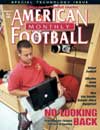AMERICAN FOOTBALL MONTHLY THE #1 RESOURCE FOR FOOTBALL COACHES
Article CategoriesAFM Magazine
|
The Information AgeComputers are changing the nature of a coach\'s job... and saving hundreds of hours tooby: Jane Musgrave © More from this issue It's the kind of argument that breaks out hundreds of times during hundreds of coaches meetings that are held at hundreds of school across the nation each week. The coaching staff at Pittsburg State University in Kansas was mulling over the team's weak spots and one coach insisted that a glaring problem was the team's inability to convert on third down. The idea caught on quickly and pretty soon the entire staff was in agreement that the Gorillas simply weren't very good in third-down situations. The lone voice of dissent was offensive line coach Bill Kroenke. But, he said, his argument didn't go very far. "I said, 'Yeah, we are,' and they said, 'No we aren't,' " he recalls. Finally, he played his trump card. "OK, I'll prove it," he told them as he left the meeting room. Ten minutes later, he returned with a tape sh....The full article can only be seen by subscribers.
|
|
|||||||
| HOME |
MAGAZINE |
SUBSCRIBE | ONLINE COLUMNISTS | COACHING VIDEOS |
Copyright 2025, AmericanFootballMonthly.com
All Rights Reserved





